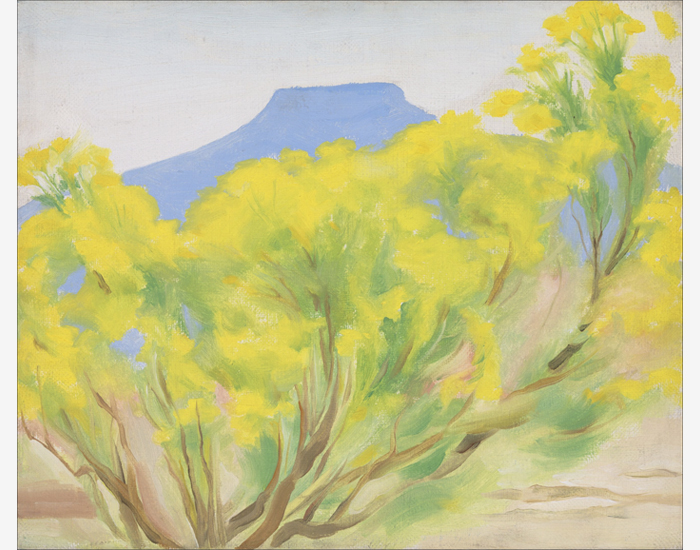GEORGIA O'KEEFFE (1887-1986)
,_new_mexico_40147.jpg)
,_new_mexico_40147_detail1.jpg)
,_new_mexico_40147_detail2.jpg)
,_new_mexico_40147_detail3.jpg)
,_new_mexico_40147_detail4.jpg)
,_new_mexico_40147_detail5.jpg)
,_new_mexico_40147_detail6.jpg)
,_new_mexico_40147_detail7.jpg)
,_new_mexico_40147_detail8.jpg)
,_new_mexico_40147_detail9.jpg)
Provenance
An American Place, New YorkMr. and Mrs. Max Ascoli, New York, 1944
Descended in family
Harold Diamond, New York, c. 1975
Gerald Peters Gallery, Santa Fe, New Mexico
Elaine Horwich Gallery, Scottsdale, Arizona, 1978
Collection of Mr. and Mrs. E. Parry Thomas, Las Vegas, Nevada, 1978
Private Collection, United States
Exhibition
New York, New York, An American Place, Georgia O’Keeffe, Paintings – 1943, January 11 – March 11, 1944, no. 8West Palm Beach, Florida, Ann Norton Sculpture Gardens, Discoveri...More...ng Creativity: American Art Masters, January 10 - March 17, 2024
Literature
Lynes, Barbara Buhler, Georgia O’Keeffe, Catalogue Raisonné Volume Two (New Haven and London: Yale University Press, 1999), cat. no. 1066, p. 670....LESS...
History
Cottonwood Tree (Near Abiquiu), New Mexico (1943) by celebrated American artist Georgia O’Keeffe is exemplary of the airier, more naturalistic style that the desert inspired in her. O’Keeffe had great affinity for the distinctive beauty of the Southwest, and made her home there among the spindly trees, dramatic vistas, and bleached animal skulls that she so frequently painted. O’Keeffe took up residence at Ghost Ranch, a dude ranch twelve miles outside of the village of Abiquiú in northern New Mexico and painted this cottonwood tree around there. The softer style befitting this subject is a departure from her bold architectural landscapes and jewel-toned flowers.
The cottonwood tree is abstracted into soft patches of verdant greens through which more delineated branches are seen, spiraling in space against pockets of blue sky. The modeling of the trunk and delicate energy in the leaves carry forward past experimentations with the regional trees of the Northeast that had captivated O’Keeffe years earlier: maples, chestnuts, cedars, and poplars, among others. Two dramatic canvases from 1924, Autumn Trees, The Maple and The Chestnut Grey, are early instances of lyrical and resolute centrality, respectively. As seen in these early tree paintings, O’Keeffe exaggerated the sensibility of her subject with color and form.
MoreMARKET INSIGHTS
According to the graph prepared by Art Market Research, Georgia O’Keeffe’s market prices have increased at an 12.7% compound annual rate of return since 1976.
Georgia O’Keeffe’s auction record was set in 2014 with the sale of Jimson Weed/White Flower No. 1 for over $44.4 million USD. This remains the highest sum paid for a female artist at auction.
Even when O’Keeffe’s market took a slight downturn during the pandemic in 2020 (as seen in the AMR graph), ArtPrice’s global index of auction turnover shows that O’Keeffe increased from 263rd to the 63rd highest sold artist that year, illustrating that O’Keeffe’s paintings remain in increasing demand, especially when compared to other artists’ performance during this same time.
- On average over the last 40 years, approximately only 4 paintings by O’Keeffe come up for sale at auction each year.
Top Results at Auction
“Jimson weed/ White flower no. 1” (1932) sold for $44,405,000 USD.
“White Rose with Larkspur No. I” (1927) sold for $26,725,000 USD.
“Black Iris VI” (1936) sold for $21,110,000 USD.
“Autumn Leaf II” (1927) sold for $15,275,000 USD.
Comparable Paintings Sold at Auction

“Red Hills with Pedernal, White Clouds” (1936) sold for $12,298,000.
- A wider view of the desert landscape, this painting was sold in the auction of Microsoft co-founder Paul Allen’s collection
- Nature was often the subject of O’Keeffe’s art, and some cottonwood trees can be seen in the distance of this landscape

“Lake George With White Birch” (1921) sold for $11,292,000.
- This early canvas with similar subject matter, though smaller-scale, sold for over $11.2 million in 2018, the third-highest auction price for O’Keeffe
- Nature subjects, particularly trees, were a frequent focus of O’Keeffe

“Near Abiquiu, New Mexico” (1931) sold for $8,412,500.
- A smaller work than Cottonwood Tree (Near Abiquiu), New Mexico
- An earlier landscape from the same area in New Mexico, this piece sold for over $8.4 million in 2018

“The Red Maple at Lake George” (1926) sold for $8,187,500.
- This O’Keeffe nature subject of the same size sold in 2018 for over $8.18 million
- Earlier example from 1926

“Nature Forms – Gaspé” (1931) sold for $6,870,200.
- Small-scale, abstract nature subject
- Sold recently for over $6.87 million
SCARCITY
- 43% of O’Keeffe’s paintings are already held in museum collections.
- Of the 616 oil on canvas works O’Keeffe painted, less than 300 remain available for private collections.
- As time goes on, many of the O’Keeffe paintings currently in private collections will be bequeathed to museums, leaving very few to ever become available.
- O’Keeffe first painted the cottonwood trees in Abiquiu for two only years, from 1943 to 1945, and only created nine paintings for this core series. Of these, 6 are held in permanent museum collections, with only 3 remaining in private hands.
- O’Keeffe’s Cottonwood Trees – from the original 1943-1945 core series and from later years – can be found in leading museum collections including the Georgia O’Keeffe Museum, the Butler Institute of American Art, and the Museum of Fine Arts Boston.
Paintings of Cottonwoods, Trees, and Abiquiu in Museum Collections
Georgia O'Keeffe Museum, Santa Fe
Santa Barbara Museum of Art
Georgia O'Keeffe Museum, Santa Fe
The Butler Institute of American Art, Ohio
Georgia O'Keeffe Museum, Santa Fe
The Cleveland Museum of Art
Dallas Museum of Art
New Mexico Museum of Art, Santa Fe
Museum of Fine Arts, Boston
Brooklyn Museum, New York
The Metropolitan Museum of Art, New York
Whitney Museum of American Art, New York
Georgia O'Keeffe Museum, Santa Fe
The Cleveland Museum of Art
Art Institute of Chicago
Image Gallery
Additional Resources
Authentication
Cottonwood Tree (Near Abiquiu), New Mexico, 1943 is listed as number 1066 in Barbara Buhler Lynes’s catalogue raisonné of Georgia O’Keeffe’s artwork. The painting is illustrated on page 670 of volume two.
See Catalogue Raisonné
Inquire
You May Also Like























































